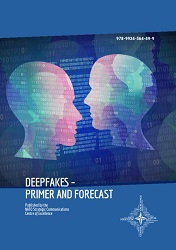Deepfakes – Primer and Forecast
Deepfakes – Primer and Forecast
Author(s): Tim Hwang
Contributor(s): Jazlyn Malnczyk (Editor)
Subject(s): Social Sciences, Economy, Media studies, Communication studies, Sociology, Theory of Communication, Policy, planning, forecast and speculation, Social Informatics, ICT Information and Communications Technologies
Published by: NATO Strategic Communications Centre of Excellence
Keywords: Deepfakes; artificial intelligence; intelligent machines; machine learning; technology; fake media; disinformation;
Summary/Abstract: “Artificial intelligence”—the broad category of study exploring the creation of intelligent machines—has enjoyed a resurgence in the last decade, driven by a combination of research breakthroughs, a massive expansion in access to data, and advances in computational hardware. New developments and applications have captured the imagination of policymakers and the public at large, inspiring both hopes and fears around artificial intelligence and its future prospects. Among the many areas of concern around the technology, perhaps one of the most widely discussed has been the threat posed by “deepfakes”: synthetic audio, images, and video generated with artificial intelligence. Deepfakes are often strikingly realistic and sometimes challenging to distinguish from the genuine article. Artificial intelligence has been used to produce deepfakes depicting prominent political figures from Donald Trump to Vladimir Putin saying a variety of things they never in fact said.
- E-ISBN-13: 978-9934-564-75-8
- Page Count: 23
- Publication Year: 2020
- Language: English
- eBook-PDF
- Introduction

